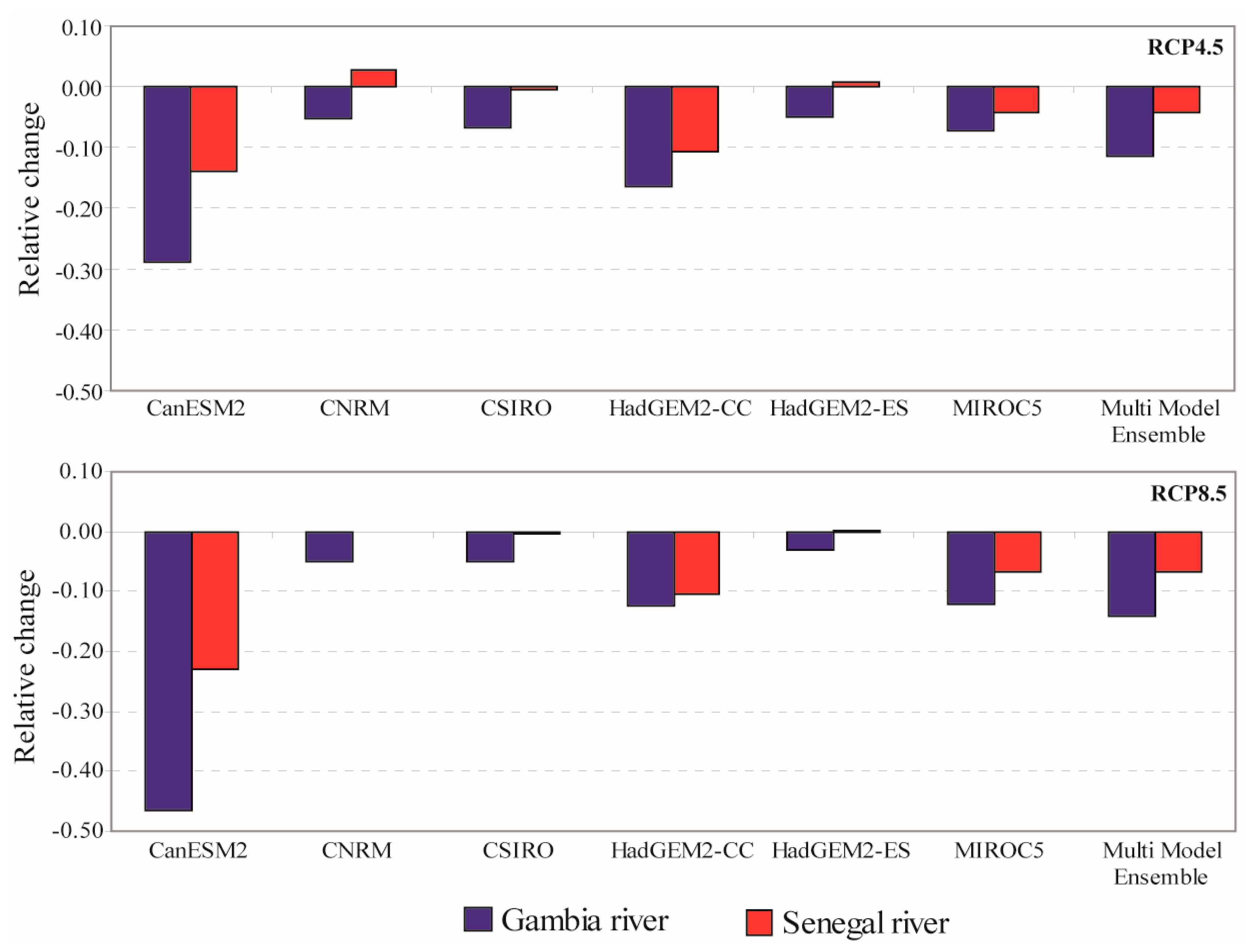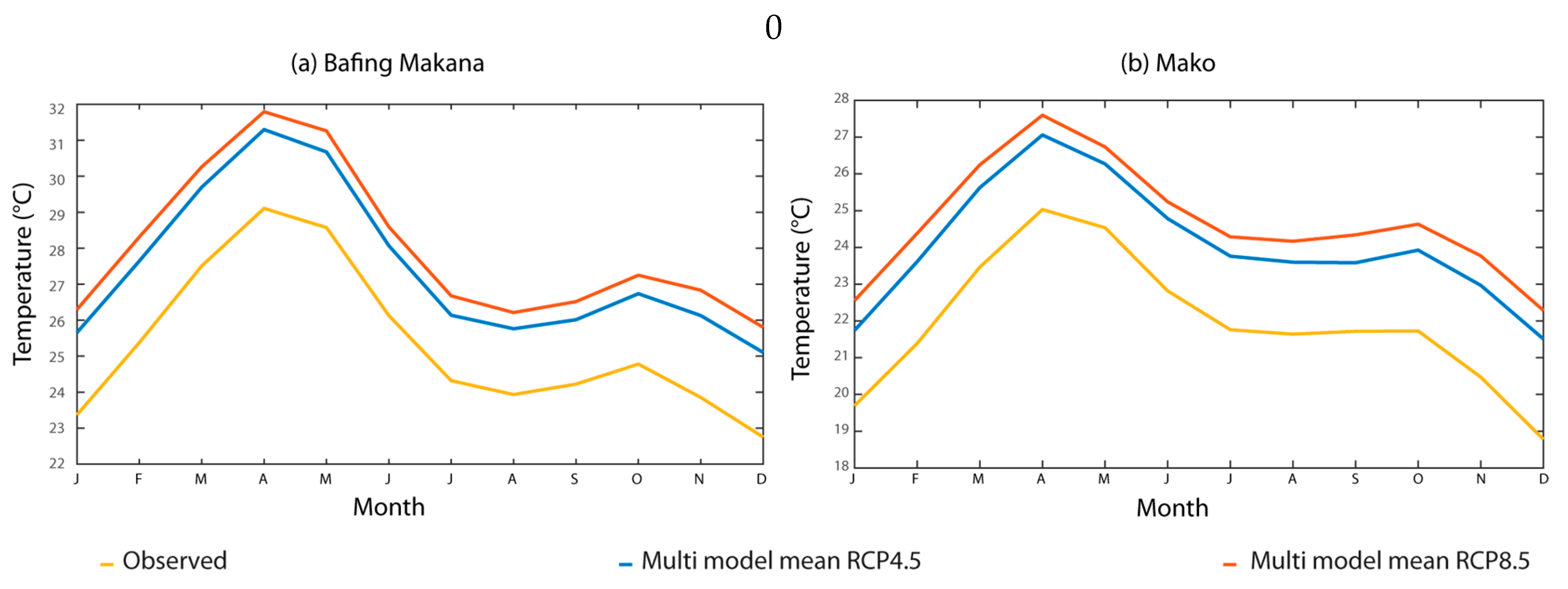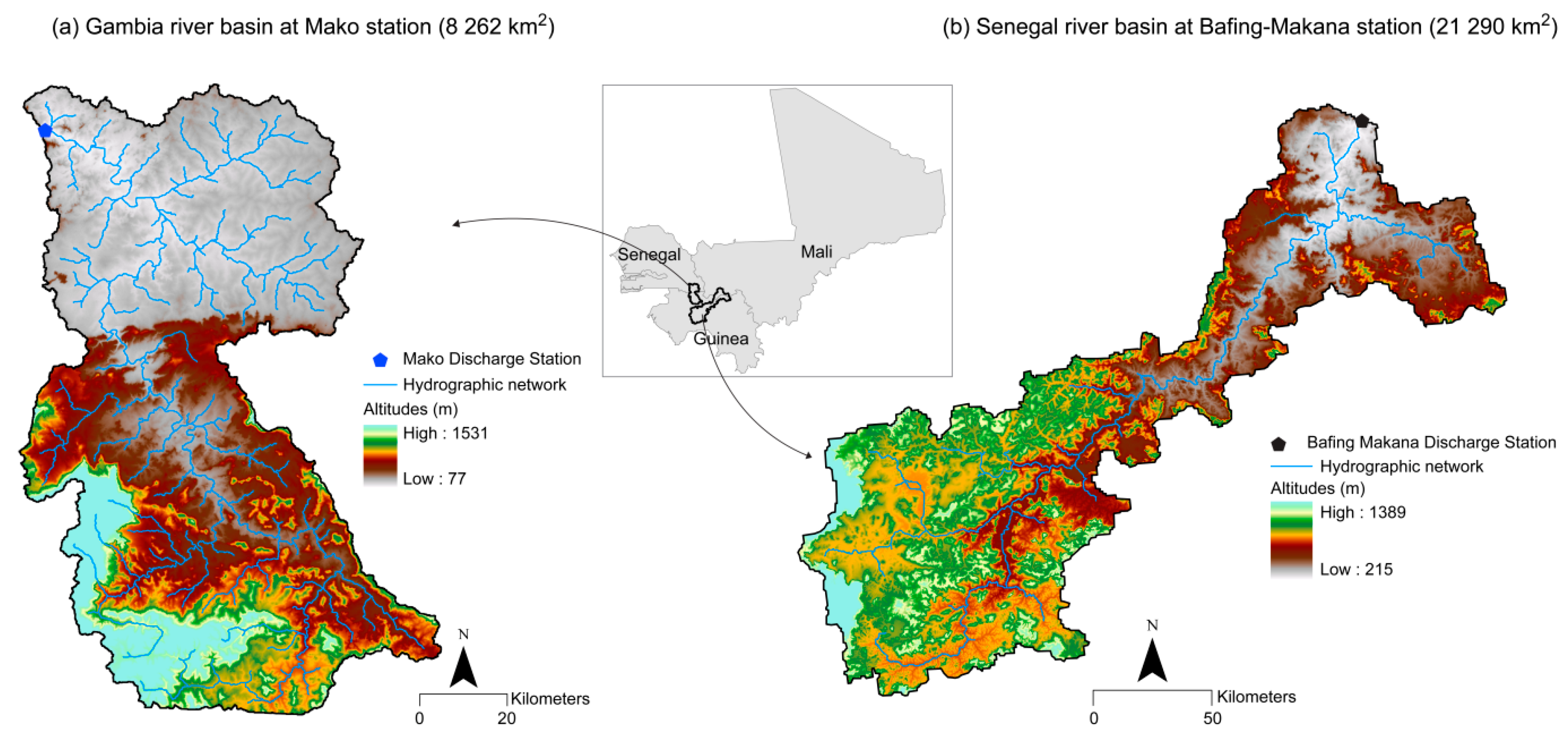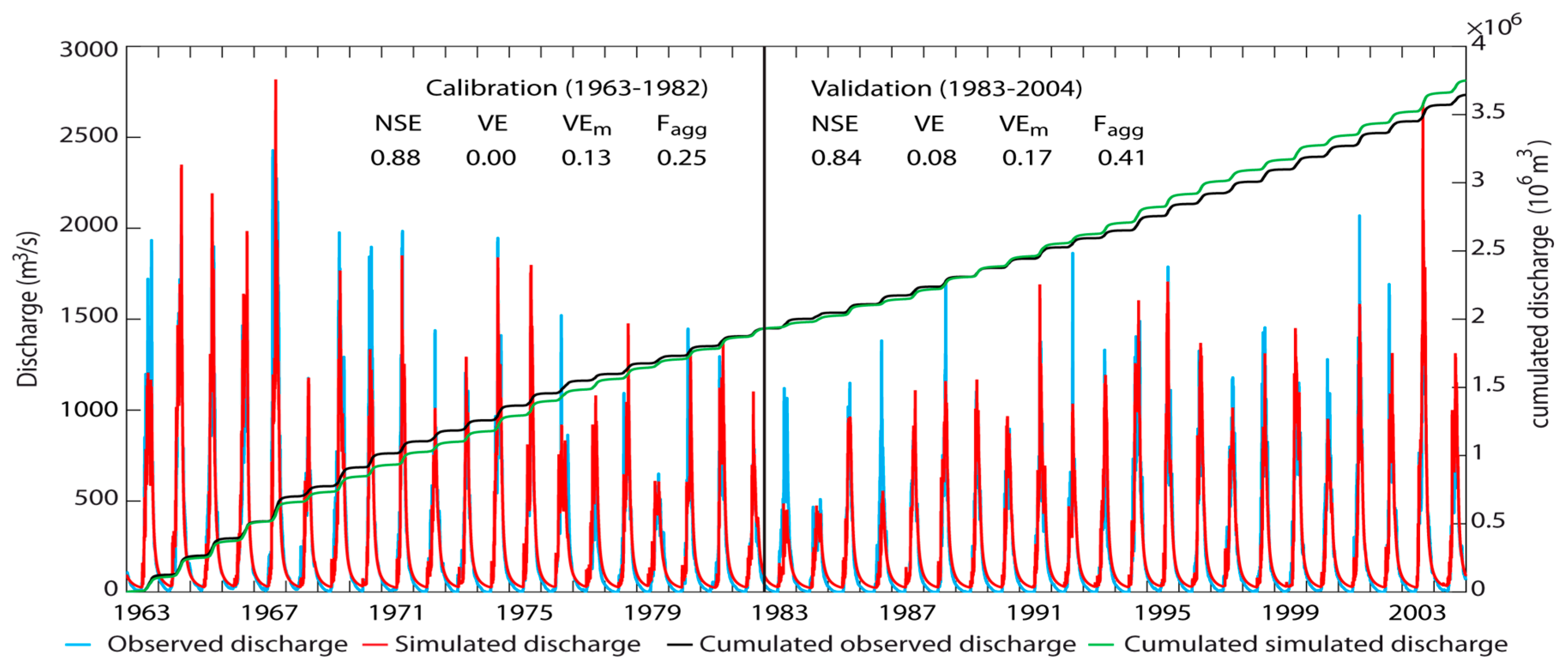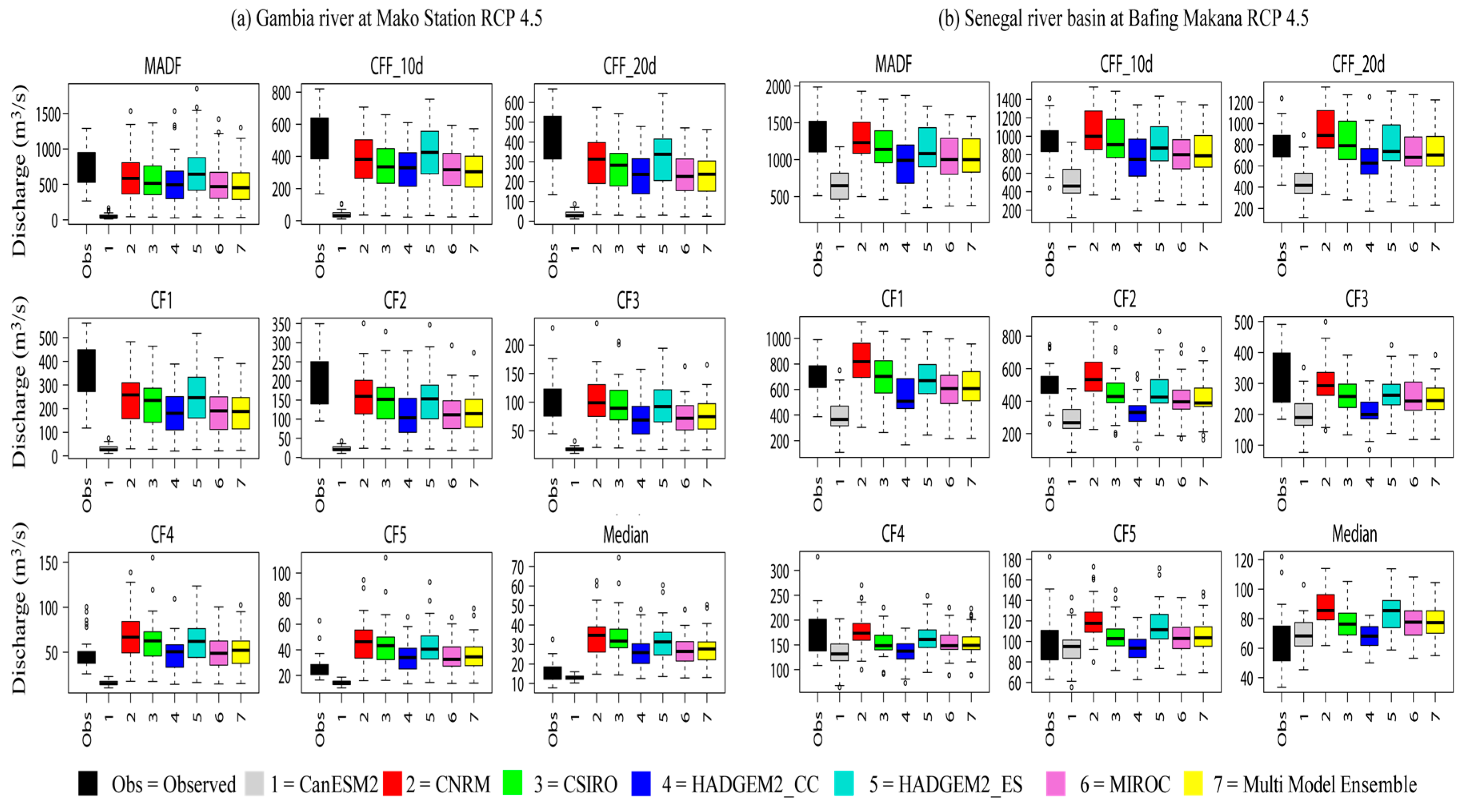1. Introduction
Availability of freshwater in sub-Saharan Africa is fundamental to economic growth and social development [
1]. In Africa, more than 70% of the population is rural and mainly depend on agriculture in which water availability is one of the most limiting factors. Among the key elements to determine the water availability, the streamflow is the major component. Therefore, it is primordial to have knowledge on streamflow in order to better assess the quantity of existing water for multiple purposes. However, hydrological cycle has been altered by human activities and climate change [
2,
3]. Therefore, it is essential to account for water inflow in order to insure a correct monitor and assessment of water for multipurpose reservoir or river basin [
2,
3]. However, a major effect of climate change is likely to be alterations in hydrologic cycles and changes in water availability [
4]. All sectors depending on water availability are now vastly exposed to the climate change impacts [
5]. Hence, climate change can also impact sediment export [
6,
7], crop yield and biomass [
8,
9], water quality [
10], etc. All these are driven by streamflow.
According to the Intergovernmental Panel on Climate Change (IPCC) [
11], nearly most regions of the world are expected to experience a net negative impact of climate change on water resources and freshwater ecosystems. Increased evaporation, combined with changes in precipitation, has the potential to affect runoff, the frequency and intensity of floods and droughts, soil moisture, and available water for irrigation and hydroelectric generation [
4]. Azari et al. [
12] highlighted that a long trend increase in temperature will considerably impact the hydrological cycle, thus changing rainfall pattern and the magnitude and timing of runoff. In Africa, climate change and its impact on water resources availability in space and time have put complex challenges to the African countries in their objective to better manage water resources and improve food security [
13]. Several studies were conducted across the world to determine the impact of climate change on streamflow under different climate models and scenarios by using a large group of hydrological models [
4,
14]. The results of these studies showed that climate change will impact considerably the availability of water resources across the world. The severity and the magnitude of the impact depend on the geographical area and context. In West Africa, Roudier et al. [
15] summarized different funding related to the impact of climate change on water resources. Overall, a decrease of rainfall going from 20% to 30% was noticed, which led to a decrease in river flows ranging from 40% to 60% [
5].
In the Senegal and Gambia River Basin, strategic areas for the development of the Senegal River Basin Organization (OMVS) countries (Guinea, Mali, Mauritania, and Senegal) and the Gambia River Basin organization (OMVG) countries (Gambia, Guinea, Bissau Guinea, and Senegal), few studies have been conducted to assess streamflow under future climate change. Bodian et al. [
16] investigated the impact of climate change on some sub-basins in the upper Senegal River Basin by using 4 GCMs (CSMK3, HADCM3, MPEH5, and NCPCM) under A2 SRES scenario and the hydrological model GR2M. They showed that some GCM models (CSMK3, HADCM3, MPEH5) predict decrease of streamflow while NCPCM GCM model exhibit the opposite. However, Bodian et al. [
16] used a model at monthly step to predict streamflow which is not adapted for flood and base-flow modeling. Recently, Mbaye et al. [
17] used the regional climate model REMO as input for the Max Planck Institute for Meteorology-Hydrology Model (MPI-HM) and found general decrease of river discharge, runoff, evapotranspiration, soil moisture under the two Representative Concentration Pathways (RCP4.5 and RCP8.5) by the end of the century in the Upper Senegal Basin (West Africa) at Bakel station. Mbaye et al. [
17] did not take into account the effect of Manantali dam in the river and used only one climate model which can bias the results. In the Gambia River Basin, only the study of Ardoin-Bardin et al. [
18] was interested to the impact of climate on river basin water resources at Gouloumbou station by using four GCM (CSIRO-Mk2, ECHAM4, HadCM3 and NCAR-PC) under the AR3 (A2) scenario and the GR2M hydrological model.
This shows the lack of study related to the evaluation of the impact of climate change on water resources in this area. Several projects have been implemented in both watersheds. At the level of the Senegal River Basin, the OMVS authorities update the objectives defined in the 70s and defined an ambitious program to increase food security, hydroelectric production and to develop irrigated agriculture; while in the Gambia River Basin, the construction of the Sambangalou Dam, a hydraulic infrastructure which project to store 3 billion of m3 of water, to produce 402 GWh/year, and to irrigate 90,000 ha of land is planned to boost agriculture, hydropower production, and water supply for riparian states. All of these ongoing and planned initiatives require information on the evolution of the water resource mainly in this context of climate change. Also any negative impacts of water supply in respect to the two important basins is likely to affect the energy production and agriculture sectors of those countries, which are the two keys elements of economic development in Africa. Therefore, it is vital to monitor, assess and predict the water availability in both Senegal and Gambia River Basins, particularly in its upstream regions that have influence of water management practices downstream of river systems. Therefore, effort need to be undertaken in order to evaluate how climate change will impact streamflow of the two main basins under the new scenarios (RCPs) using several climate models. The main objective of this study is to quantify the near future (2036–2065) of climate change impact on streamflow at Senegal and Gambia River Basins by using daily hydrological model and six different climate models under RCP4.5 and 8.5. The output from this research will allow the OMVS and OMVG Authorities to improve water management and planning of future developments in OMVS and OMVG countries in the context of climate change.
4. Discussion and Conclusions
Predicting the change in water volume in river basins are crucial because it helps to have an idea of water storage of hydraulic infrastructures like the Manantali Dam. It also permits the evaluation of the adequacy between user demand and the availability of water, thus managing probable conflicts between users and sectors. For the near future (2050 horizon), compared to the 1971–2000 reference period, results showed that for the two river basins, the multi-model ensemble predicted a decrease of annual streamflow. This decrease of annual streamflow will be more pronounced in the Gambia River Basin. A combination of increase of temperature (
Appendix C) and decrease in annual rainfall (
Appendix B) may explain this decrease of annual streamflow. The decrease was more pronounced in the Gambia River Basin, which may be related to the greatest decrease of rainfall in that area. This decrease of streamflow is consistent with recent findings of Biao [
3] in the Oueme River Basin (Benin, West Africa). In his study, he used two regional climate models (HIRHAM5 and RCA4) and the HyMoLAP hydrological model to assess the impacts of climate changes on river discharge dynamics. He showed that the projected mean annual river discharge in Bétérou and Bonou stations decreased from −25% to −39% and −20% to −37%, respectively, under RCP4.5 and from −15% to −34% and −18% to −36% under RCP8.5. These results confirm that streamflow is vastly sensitive to both temperature and rainfall [
46]. However, these results are not in agreement with the finding of Angelina et al. [
20] who showed an increase of mean annual flow of the Niger river basin at Koulikoro by 6.9% (2026–2050), 0.9% (2051–2075), and 5.6% (2076–2100) by using a SWAT model under the SRES A1B emissions scenario. Additionally, Azari et al. [
12] showed an increase in stream-flow under RCP4.5 and RCP8.5 in the Gorganroud River basin in the North of Iran. The differences in hydrological models used as well as the area of study (difference in climate, soil, relief, land use, etc.) may be key factors determined for this difference. In fact, streamflow depends not only on climate variables but on other variables which may considerably impact the modeling results. Thus, a modeling study has to be site-specific and cannot be generalized. Faramarzi et al. [
13] concluded that the African continent will experience an increase of mean annual quantity of water resources, however, they pointed out that variations (increasing or decreasing) are specific to individual sub-basins and countries. Some sub-basins may exhibit increases in mean annual runoff and others, the inverse.
It is to be noticed that GR4J gave poor results to simulate low flow. In fact, the model presents some weakness to simulate base flows because it does not fully account for groundwater and groundwater-surface flow links [
21]. It is true that other models exists that properly account for surface water and ground water interactions [
47,
48]. Their application at the scale of the upper Senegal and Gambia River Basins is difficult due to the complexity of the hydrogeological context, as well as the scarcity of hydrogeological data. New soft computing techniques [
49] may be an alternative to improve streamflow modeling and forecasting in these areas. It is hoped that future research efforts will focus in these directions to explore the application of these different methods to see if they can bring added value in the simulation of flows. Additionally, GR4J does not take into account the dynamics of land use in simulating discharge and any change in land use in the future can impact runoff [
50]. Even though GR4J does not consider land use, however, with changing trends of other parameters in the river basins, like rainfall [
51], the calibrated and validated model gave good accuracy in simulating the streamflow. Furthermore, the inability of the GR4J model to consider the integrated cycle of atmosphere-water-vegetation would have introduced significant uncertainty in the modeling results. For future research, it would be interesting to use hydrological models that integrate land use dynamics, like SWAT. GCM have great difficulties taking into account regional heterogeneities of variability and changes of climate, according to Biao [
5]. Therefore, these models may not be suitable to produce climate projections at regional, national, and local scales, which are necessary to assess the impacts of climate change and to develop adaptation policies [
52]. In recent years, some initiatives, like the Coordinated Regional Climate Downscaling Experiment (CORDEX AFRICA), have been implemented to produce climate-projected variables at regional scales from Regional Climate Models (RCM) forced by GCM outputs in the West Africa region with a spatial resolution of 50 km. In this regard, it will be interesting to compare results from GCM and RCM.
Therefore, these results must be handled with caution because of some difficulties inherent to hydrological modeling and uncertainties from climatic models and downscaling methods. Even though progress in climatic models have been noticed in recent years, there are some biases from climate output models [
18] which exclude their use without applying methods of correction. The delta downscaling method used in this study gave poor results for extreme values [
39]. Yet, the use of the bias correction generally has the inconvenience of not taking into account the different physical laws that govern the atmosphere [
53]. However, Angelina et al. [
20] showed that the quantile-quantile transformation can improve the simulation of extreme values. It is also necessary to take into account difficulties associated with the transfer of the parameters of the hydrological model on periods other than those where the model was calibrated. In fact, the values of model parameters of a climatic and environmental situation met during a period in a river basin may not be the same in a different context [
54] and this may produce errors. Therefore, modeling results cannot be presented in terms of forecasting, rather as an approach on the evolution of the resource in water in terms of risk under particular hypotheses of changes of climate.
The outputs of this research suggests defining, designing, and developing suitable adaptation measures to promote resilience to climate change in order to improve water security in the two basin. This will require new policies and adaption techniques and technologies in order to better manage water resources in these basins. The particularity of the Senegal and Gambia River Basins shared by many countries requires a powerful “win-win” cooperation between all the stakeholder countries. Therefore, OMVS and OMVG will remain the ideal motor to enhance new strategies and policies to tackle the negative effect of climate change. The results indicated negative impact of climate change, particularly for the high flow, and suggest the importance of integrating this analysis into adaptive management plans and programs. This study will be helpful to decision-makers of the two river basin organizations for adaptive water resource management practices in the context of climate change. However, it is to be noticed that this research investigated the impact of climate change on streamflow and did not take into account the adequacy between availability and demand for water resources. Therefore, it will be valuable to examine how climate change will impact the different users of the Senegal and Gambia River Basin water resources and investigate the adequacy between demand and available water resources in different horizons and different scenarios. This study is a first step.
